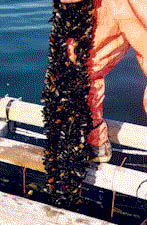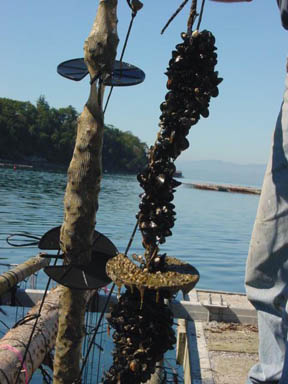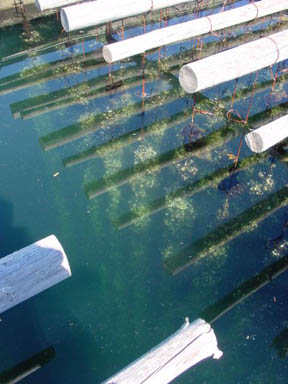Thinning & Transplanting Mussels
As summer progresses, the mussel seed grows rapidly on the lines and by August they are about 2 centimeters in length. The density at which they settled on the line is so great that the mussels will need to be thinned out so to allow for quicker and more uniform growth.

Left - A heavily set Penn Cove Mussel seed collector which needs to be stripped and thinned out into mussel socks in order that it can grow more quickly and to a uniform size.
Starting in late summer the thinning process begins. Each one of the thousands of seed collector lines is pulled up and stripped bare on to the deck of our seed barge.
The "seed" mussels are then fed onto a conveyor which feeds a "socking" machine or a group of socking tables; where our Disc-Net-Line System is used to transplant the mussel seed onto re-usable plastic lines at a density of about 150 mussels per foot of line. Each seed line will yield between 2 to 3 mussel harvest lines, each of the lines of mussels are 7 meters long.

Left - A newly transplanted Disc-Net-Line on the left and a line three weeks after transplant where the cotton sock has rotted away.
Once filled, each of the socks are hung from a mussel raft where they will stay and grow until they reach harvest size. The seed mussels in the sock put out byssal threads attaching themselves to the sock and one another; and the eventually grow through the mesh of the sock and appear to be a solid column of mussels once fully grown. Each sock once fully grown, may weigh upwards of 100 pounds, this is generally within 11 to 12 months of when the mussel seed was first collected.

Left - Mussels growing out through the cotton mussel sock and being supported along the sock with our "Mussel Discs", which are specifically designed to help support the weight of the mussels on the sock as they grow.
For more information about the Mussel Discs, click on the link to our Mussel Disc page.
